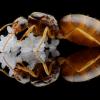They are both hanging out on opposite sides of the test tube.
Unlike the many other multiple Pheidole queen setups I have which all hang out close to each other, and feed one another etc.
I saw a leg on the test tube ceiling, and upon examining the photos I took today, the one of the entrance side is missing a leg...
AFAIK They are the same species. The one on the water side is definitely all black.
They have some brood and one pupa is getting close to eclosing, the brown one.
click to enlarge




















